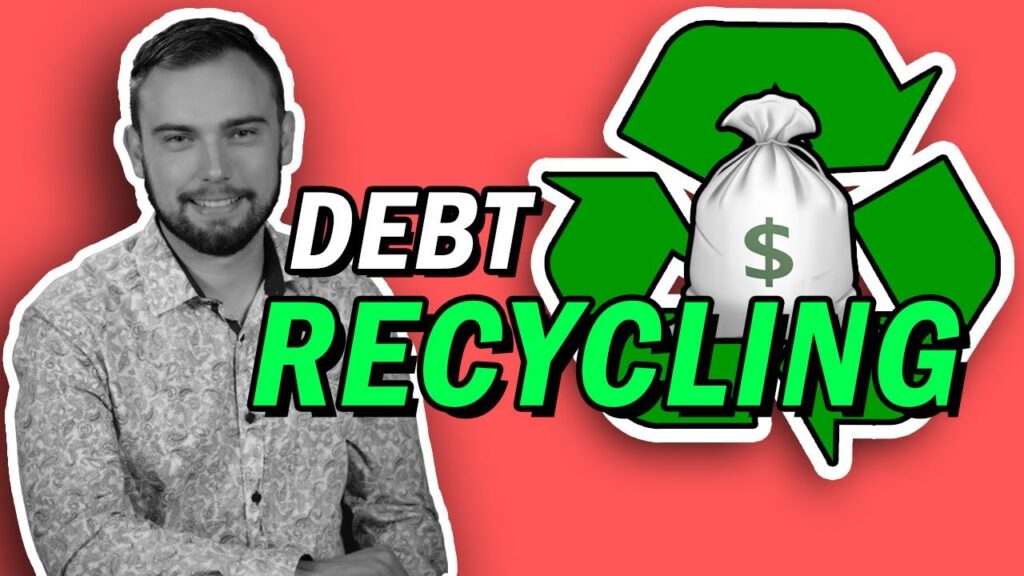Debt recycling is a financial strategy that allows individuals to take advantage of the tax benefits associated with borrowing money to invest and, at the same time, minimize their liabilities. By understanding the basics of debt recycling and the intersection of debt recycling and taxation, individuals can implement effective strategies to enhance their returns while managing their liabilities. However, it is important to consider the potential risks and important considerations before implementing debt recycling.
Understanding Debt Recycling
Debt recycling is a concept that involves using borrowed funds to invest in income-generating assets. ATO debt recycling is based on the idea that the interest paid on the borrowed funds can be offset against the investment income, resulting in potential tax benefits. This strategy allows individuals to leverage their investments and potentially increase their returns.
One key aspect to consider when implementing debt recycling is the choice of investment assets. It is important to select assets that have the potential to generate consistent income over time, such as dividend-paying stocks or rental properties. By carefully choosing the right investments, individuals can maximize the benefits of debt recycling and enhance their overall financial position.
See Also: Superannuation Estate Planning For Ensuring Your Assets Are Protected

The Basics of Debt Recycling
At its core, debt recycling involves three key steps: borrowing money, investing the borrowed funds, and using the investment income to pay down the debt. By repeating this cycle, individuals can continuously recycle their debt and potentially increase their investments over time. This strategy requires careful financial management and a thorough understanding of the tax implications.
Another important consideration in debt recycling is the concept of compound interest. By reinvesting the investment income back into the assets, individuals can benefit from compounding returns, leading to accelerated growth of their investment portfolio. This compounding effect can significantly boost the overall returns generated through debt recycling over the long term.
The Role of Debt Recycling in Financial Management
Debt recycling plays a crucial role in financial management by providing individuals with the opportunity to leverage their investments and potentially increase their wealth. It allows individuals to make use of their existing assets and investments to generate additional income, while also minimizing their tax liabilities.
Furthermore, debt recycling can serve as a strategic tool for individuals looking to build long-term wealth and achieve financial independence. By effectively managing their debts and investments through this strategy, individuals can create a sustainable source of passive income that can support their financial goals and aspirations.
The Intersection of Debt Recycling and Taxation
Debt recycling interacts with tax laws in various ways and offers several tax benefits to individuals. Understanding these interactions is essential for maximizing the potential returns and minimizing tax liabilities associated with debt recycling.
When delving into the intricate world of debt recycling and taxation, it is crucial to grasp the nuances that can significantly impact one’s financial strategy. By strategically leveraging debt to invest in income-producing assets, individuals can unlock a realm of tax advantages that can propel their wealth accumulation journey to new heights.

How Debt Recycling Interacts with Tax Laws
Debt recycling involves borrowing money to invest in income-producing assets. The interest paid on the borrowed funds can be claimed as a tax deduction, reducing the overall taxable income. This can result in potential tax savings and can help individuals minimize their tax liabilities.
Moreover, the synergy between debt recycling and tax laws extends beyond mere deductions. By intelligently structuring debt recycling endeavors, individuals can navigate the complex tax landscape with finesse, optimizing their financial position and paving the way for long-term prosperity.
Tax Benefits Associated with Debt Recycling
One of the key tax benefits associated with debt recycling is the ability to claim tax deductions on the interest expenses incurred for the borrowed funds. This reduces the taxable income and can potentially result in significant tax savings. Additionally, individuals may also be able to claim depreciation deductions on the investment property, further reducing their tax liabilities.
Furthermore, the symbiotic relationship between debt recycling and taxation opens up avenues for strategic tax planning, enabling individuals to harness the power of compounding returns and tax efficiencies. By staying abreast of the ever-evolving tax regulations and leveraging debt recycling techniques effectively, individuals can chart a course towards financial freedom and prosperity.
Strategies for Minimising Liabilities
To effectively minimize liabilities, individuals should implement proven debt management techniques and leverage the benefits of debt recycling.
When it comes to managing liabilities, having a solid understanding of one’s financial situation is key. By creating a detailed budget that outlines income, expenses, and debt obligations, individuals can gain clarity on their financial health and identify areas where liabilities can be minimized. This proactive approach can help in developing a strategic plan to reduce debt and improve overall financial well-being.
Effective Debt Management Techniques
Managing debt plays a critical role in minimizing liabilities and maximizing returns. It is important to carefully assess the borrowing capacity, interest rates, and repayment terms to ensure that the debt is manageable and aligned with the individual’s financial goals. Regularly reviewing and refinancing debt can also help individuals take advantage of lower interest rates and potentially reduce their ongoing repayments.
Another effective debt management technique is debt consolidation, where multiple debts are combined into a single loan with a lower interest rate. This can simplify the repayment process and potentially save money on interest payments over time. By focusing on paying off high-interest debts first and making consistent payments, individuals can make significant progress in reducing their overall liabilities.
Reducing Liabilities through Debt Recycling
Debt recycling can be a powerful strategy for reducing liabilities. By using the investment income to pay down the debt, individuals can accelerate the repayment process and potentially save on interest expenses. This allows individuals to build equity and increase their net worth over time.
Furthermore, leveraging tax-efficient strategies like offset accounts or redraw facilities can help individuals reduce their interest payments and pay off their debts faster. By strategically allocating funds and taking advantage of available financial tools, individuals can effectively minimize their liabilities and work towards achieving their long-term financial goals.

Maximising Returns through Debt Recycling
Debt recycling not only helps individuals minimize their liabilities but also has the potential to enhance returns on their investments.
When considering debt recycling as a financial strategy, it’s essential to delve deeper into the mechanisms that drive its effectiveness. By strategically leveraging existing assets and liabilities, individuals can unlock a world of opportunities to optimize their financial standing. Debt recycling allows for a dynamic approach to wealth management, where individuals can harness the power of borrowed funds to amplify their investment potential.
The Impact of Debt Recycling on Returns
Debt recycling has the potential to significantly impact investment returns. By leveraging borrowed funds, individuals can increase their investment capacity and potentially achieve higher returns. Additionally, the tax benefits associated with debt recycling can further enhance the overall returns.
Furthermore, the concept of debt recycling extends beyond mere financial gains. It fosters a mindset of strategic financial planning and responsible leveraging, empowering individuals to make informed decisions about their wealth accumulation. By understanding the intricate relationship between debt, investments, and returns, individuals can navigate the complex financial landscape with confidence and foresight.
Strategies for Enhancing Returns with Debt Recycling
To enhance returns with debt recycling, individuals should carefully select income-generating assets that have the potential for long-term growth and attractive yields. Diversification is also key to minimize risk and maximize overall returns. Regular monitoring of investments and adjustments to the debt recycling strategy can help individuals capitalize on market opportunities and optimize returns.
Moreover, incorporating a forward-looking approach to debt recycling can yield substantial benefits in the long run. By staying attuned to market trends, economic indicators, and investment opportunities, individuals can fine-tune their debt recycling strategy for maximum returns. Embracing a proactive stance towards financial management can pave the way for sustained growth and prosperity.
Risks and Considerations in Debt Recycling
While debt recycling can offer numerous benefits, it is important to consider the potential risks and important considerations before implementing this strategy.
Potential Risks of Debt Recycling
One of the key risks of debt recycling is the potential for investment losses. As with any investment strategy, there is always a level of risk involved. It is crucial to carefully assess the investment opportunities and seek professional advice to ensure that the investments align with the individual’s risk tolerance and financial goals.
Another risk to consider is the possibility of interest rate fluctuations. Debt recycling often involves borrowing against the equity in a property to invest in other assets. If interest rates rise significantly, the cost of borrowing may increase, potentially impacting the overall profitability of the strategy. It is important to factor in potential interest rate changes and have contingency plans in place to mitigate any adverse effects.
Important Considerations before Implementing Debt Recycling
Before implementing debt recycling, individuals need to consider their personal circumstances, financial goals, and risk appetite. It is important to have a solid understanding of the tax implications and consult with financial advisor or tax professionals to ensure that debt recycling is suitable for their specific situation.
Additionally, individuals should carefully evaluate their cash flow and ability to service the additional debt. Debt recycling involves taking on additional borrowing, which means there will be increased loan repayments to manage. It is crucial to have a comprehensive budget in place and assess whether the individual’s income can comfortably cover the additional financial obligations.
In conclusion, debt recycling can be a powerful strategy for minimizing liabilities and maximizing returns. By understanding the basics of debt recycling, the intersection of debt recycling and taxation, and implementing effective strategies, individuals can potentially achieve significant tax benefits and enhance their overall financial position. However, it is important to carefully consider the potential risks, such as investment losses and interest rate fluctuations, and seek professional advice to ensure that debt recycling aligns with personal circumstances and financial goals. Additionally, individuals should thoroughly evaluate their cash flow and ability to manage the increased debt obligations. Taking these considerations into account will help individuals make informed decisions and maximize the potential benefits of debt recycling.

